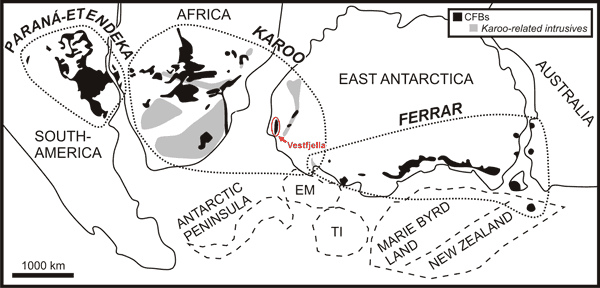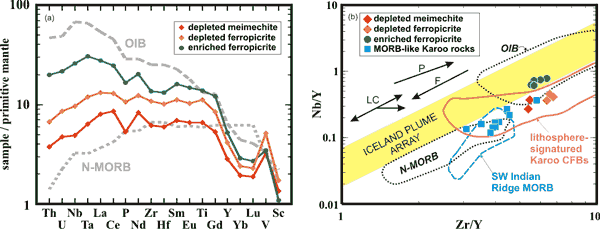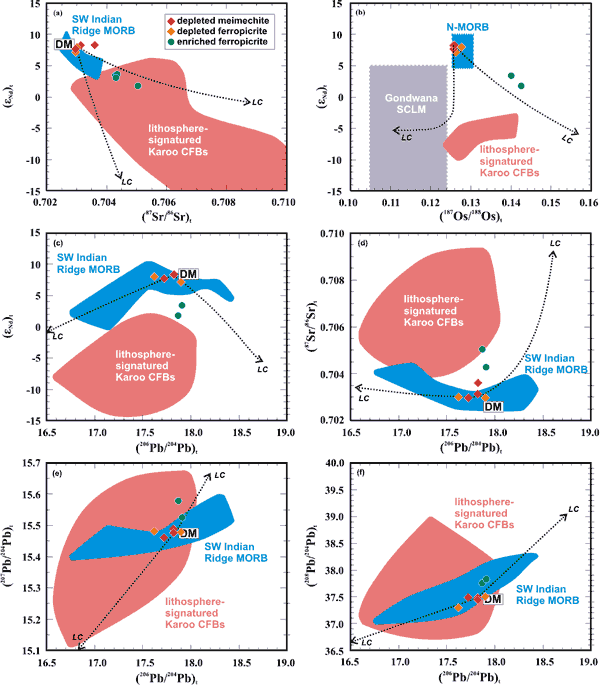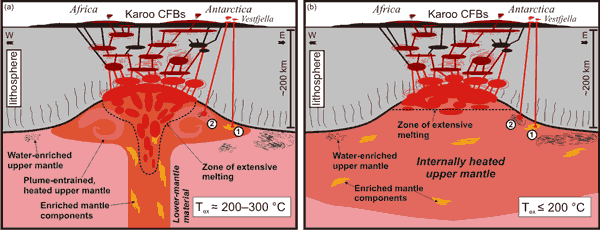 |
The
highly magnesian dike rocks of Vestfjella (western
Dronning Maud Land, Antarctica): implications
for sublithospheric mantle sources and the
origin of the Karoo large igneous province |
Jussi
S. Heinonen1 & Arto V.
Luttinen2
1Department of Geosciences
and Geography, P.O. Box 64, University of Helsinki,
00014 Finland, tel: +358-9-191-50802; jussi.s.heinonen@helsinki.fi
2Finnish Museum of Natural
History, P.O. Box 17, University of Helsinki, 00014
Finland, tel: +358-9-191-28745; arto.luttinen@helsinki.fi
Introduction
The Karoo large igneous
province (LIP) represents a huge (original volume ~2
x 106 km3; Richards
et al., 1989) manifestation of continental flood
basalt (CFB) volcanism associated with the breakup
of the Gondwana supercontinent at~180 Ma (Figure
1). The remnants of this province are mainly found
in southern Africa, but they are also exposed in
the ice-free cliffs of western Dronning Maud Land,
Antarctica (Figure 1). The mantle sources of the
Karoo LIP have been extensively studied, yet scientific
consensus has not been reached. A mantle plume model,
first suggested for Karoo by Burke & Dewey (1972)
(cf. Richards et al., 1989), has recently
been supported based on paleostress estimates (Curtis
et al., 2008) and findings of high-T magnesian
rocks (Riley et al., 2005), although structural
analyses, geochemical affinities, and temporal relationships
indicate a major role for continental lithosphere
in Karoo magmatism in general (e.g., Hawkesworth
et al., 1984; Cox, 1988; Ellam & Cox,
1989; Luttinen et al., 1998; Luttinen & Furnes,
2000; Jourdan et al., 2004, 2005, 2006,
2007a, 2007b). Volcanic rocks that show unambiguous
compositional indications of sublithospheric mantle
sources are rare (Duncan et al., 1990; Luttinen
et al., 1998) and seem to postdate the main
Karoo phase by ~10 Ma (Jourdan et al., 2007b).
These observations have inspired some to suggest
that sublithospheric sources are not needed at all
and that the primary melts of the Karoo CFBs were
invariably derived from lithospheric mantle (e.g.,
Scenario 1 of Jourdan et al., 2007a; Ed:
see also other
pages on the Karoo).
The involvement of a possible mantle plume, however,
has been difficult to address without compositional
constraints on the sublithospheric mantle beneath
Karoo LIP. Here we summarize the results on recently
discovered highly magnesian dike rocks from Antarctica
and discuss the implications of our findings to Karoo
magma sources (Heinonen & Luttinen,
2008, 2010; Heinonen
et al.,
2010).

Figure 1: Distribution of Mesozoic
CFBs in reconstructed Gondwana supercontinent. In the
case of the Karoo province, the known extent of intrusive
equivalents (found outside CFBs) is also shown. EM=Ellsworth-Whitmore
Mountains, TI=Thurston Island. See Heinonen
et al. (2010) for references.
Highly magnesian dike rocks of Vestfjella
As is typical of the Karoo LIP, the CFBs of western
Dronning Maud Land are characterized by significant
geochemical heterogeneity that has been attributed
to contamination by (or derivation from) the lithosphere
and/or variably subduction-influenced upper mantle
sources (Luttinen et al., 1998; Luttinen & Furnes,
2000). The crosscutting dike rocks of Vestfjella,
however, include some of the most extraordinary rock
types of the Karoo LIP. These are remarkably Mg-
and Fe-rich ferropicrites (FeOtot = 13–17 wt.
%; MgO = 13–19 wt. %; Heinonen & Luttinen,
2008) and meimechites (FeOtot = 13 wt. %; MgO = 19–28
wt. %; Heinonen & Luttinen, 2008, 2010).
Ferropicrites
The Vestfjella ferropicrites consist of two distinct
geochemical types (Heinonen & Luttinen,
2008; Heinonen et al.,
2010):
-
The depleted type exhibits geochemical
MORB-affinities with depletion of the most incompatible
elements, very high initial εNd of +7.2
to +8.0, and low initial 187Os/188Os
of 0.1263–0.1277
at 180 Ma (Figures 2 and 3). In fact, the isotopic
signature of the depleted type is indistinguishable
from that of MORB of the SW Indian Ridge (Figure
3), the modern successor of the Jurassic Africa-Antarctica
rift (cf. Figure 1).
-
The enriched type (including a Fe-Mg-rich basalt)
exhibits trace element characteristics similar to
those of OIB (e.g., high Nb/Y), high (Sm/Yb)N
(4.9–5.4), moderately high initial εNd
of +1.8 to +3.6 and high initial 187Os/188Os of 0.1401–0.1425
at 180 Ma (Figures 2 and 3). Isotopic compositions
and trace element characteristics indicate that
both magma types have avoided significant interaction
with the continental crust (Figure 3). Preliminary
age data indicates that the depleted type is related
to the main phase of Karoo magmatism at ~180 Ma
ago (Kurhila et al., 2008; Luttinen
et al., in prep.).

Figure 2: Geochemistry of the Vestfjella
ferropicrites and associated rocks shown in primitive
mantle-normalized incompatible element diagram (a)
and logarithmic Nb/Y vs. Zr/Y diagram (b). Compositions
of N-MORB and OIB are shown for comparison. In addition,
SW Indian Ridge MORB, representative lithosphere-signatured
Karoo CFBs, and rare Karoo-related rocks that exhibit
MORB-affinities shown in b. The Iceland Plume Array
in b indicates the composition of Nb-enriched Icelandic
basalts that have been interpreted to derive from a
mantle plume (Fitton et al., 2003). P and
F arrows denote the effect of increasing pressure and
degree of melting, respectively (cf. Fitton et
al. 1997). LC arrows denote the effect of lithospheric
contamination with compositions that are considered
to be representative of the Gondwanan lithosphere (cf.
Heinonen et al., 2010). See Heinonen
et al. (2010) for
references. Click here or
on figure for enlargement.

Figure
3: Initial εNd vs. 87Sr/86Sr
(a), εNd
vs. 187Os/188Os (b), εNd
vs. 206Pb/204Pb
(c), 87Sr/86Sr vs. 206Pb/204Pb (d), 207Pb/204Pb vs. 206Pb/204Pb (e),
and 208Pb/204Pb vs. 206Pb/204Pb (f)
of the Vestfjella samples in comparison with isotopic
data for Karoo CFBs and SW Indian Ridge MORBs (N-MORB
in b). DM denotes average depleted MORB mantle
of Workman & Hart
(2005). All data calculated at 180 Ma. In the case
of MORB and DM, the Sr, Nd, and Pb isotopic compositions
of the mantle sources were back-calculated at 180
Ma using mantle reservoir composition recommended
by Workman & Hart
(2005). Os isotopic compositions of N-MORB were
back-calculated by using 187Re/188Os ratio
of 0.06. LC denotes the effects of lithospheric
contamination. Details of the contamination models
and references are given in Heinonen
et al. (2010).
Click here or
on figure for enlargement.
Meimechites
The Vestfjella meimechites are typified
by highly abundant olivine phenocrysts with remarkably
high forsterite contents (up to Fo92) in
some of the samples (Heinonen & Luttinen,
2010). We have estimated the parental melts of these
meimechites to contain up to 25 wt. % of MgO and the
presence of igneous amphibole implicate relatively
high H2O contents of 1–2 wt. % (Heinonen & Luttinen,
2010). The Vestfjella meimechites show similar geochemical
and isotopic characteristics to the depleted type ferropicrites
and are likely to be representatives of the depleted
type parental melt compositions (Heinonen & Luttinen,
2010; Heinonen et al.,
2010).
Sublithospheric mantle sources for Karoo magmatism
The isotopic similarity between the
depleted ferropicrites, meimechites, and SW Indian
Ridge MORB suggests broadly similar upper mantle sources
for these magma types. The geochemical differences, e.g.,
the higher Sm/Yb, Nb/Y, and Zr/Y in the Vestfjella
depleted types, can be largely attributed to different
degrees and pressures of initial melting (Figure 2; Heinonen
et al.,
2010). We regard the meimechite parental
melts to represent low-degree peridotite melts (≥ 3%)
generated at considerably high temperatures (Tp > 1600°C)
and pressures (~5–6 GPa) (Heinonen & Luttinen,
2010). In Vestfjella there are also depleted basaltic
dikes that are in many respects geochemically intermediate
between the meimechites and the modern SW Indian Ridge
MORB (Luttinen et al., 1998; Heinonen
et al.,
2010). Our modeling implicates that these
dikes could represent uncontaminated parental melt
compositions of many Vestfjella lavas (Luttinen & Furnes,
2000; Heinonen, in prep) suggesting that the
depleted upper mantle source of the Vestfjella
ferropicrites and meimechites have been involved in
the petrogenesis of at least some of the Karoo CFBs.
It is important to note that although this source could
be generally considered as “ambient upper mantle”,
minor enrichments in, e.g., LILE and 87Sr/86Sr in
the Vestfjella depleted types and SW Indian Ridge MORB
infer the presence of diluted recycled lithospheric
components in the mantle source (Figure 3a; Rehkämper & Hofmann,
1997; Janney et al., 2005; Heinonen & Luttinen,
2008; Heinonen et al.,
2010).
In contrast, the OIB-like compositions of the enriched
type ferropicrites are suggestive of derivation from
recycled or melt-metasomatized pyroxenite-bearing portions
of either lithospheric or sublithospheric upper mantle
(Heinonen et al.,
2010). Based on just isotopic
compositions, the enriched type could have been generated
by lithospheric contamination of depleted type magmas
(Figure 3). The overall geochemical compositions, such
as higher FeOtot, Ti/Zr, and Nb/Y of the enriched type,
are not readily compatible with such a scenario, however
(Figure 2b; Heinonen et al.,
2010).
Implications for the origin of the Karoo CFBs
Given that the depleted type ferropicrites
and meimechites are coeval with the main phase of Karoo
magmatism, the high mantle temperatures (Tp > 1600°C;
Tex ≈ 200°C) required by the
meimechites indicate a significant thermal anomaly
in the sub-Gondwanan upper mantle at 180 Ma (Heinonen & Luttinen,
2010). Exceptionally high mantle temperatures (i.e.
hotspots) have been commonly ascribed to mantle plumes.
In the case of the depleted type ferropicrites and
meimechites of Vestfjella, a plume model would require
the source to be quite exceptional in being isotopically
and also chemically akin to ambient upper mantle. Furthermore,
we consider that generation of such a source by entrainment
of ambient upper mantle material into a plume head
is unlikely given the very high temperatures involved
and the absence of other high-T Karoo magmas that would
be expected to form within a plume (Figure 4a). The
internal mantle heating model seems to provide a more
feasible explanation for the combination of high temperatures
and upper mantle geochemical signature of the depleted
type ferropicrites and meimechites (Figure 4b; Gurnis,
1988; Coltice et al., 2007, 2009; Heinonen
et al.,
2010). In comparison, the enriched type
ferropicrites are compatible with both plume and internal
mantle heating models: they are compositionally similar
to oceanic hotspot magmas postulated to be associated
with plume activity, but they could have been derived
equally well from enriched portions of heterogeneous
sub-Gondwanan upper mantle (Figure 4).

Figure 4: Schematic presentations
of a plume model (a) and an internal mantle heating
model (b) to explain the generation of the Karoo
CFBs. Circles 1 and 2 denote the sources of the enriched
and depleted type magmas, respectively. Tex denotes
the approximate maximum temperature difference between
the heated areas and the ambient mantle: values in
a after Putirka (2008) and in b after Coltice et
al. (2007). Click here or
on figure for enlargement.
Further considerations
Although our findings mainly lend support to the internal
mantle heating model (Coltice et al., 2009),
there are some important ambiguities with regard to
the implications of this result for Karoo magmatism
in general.
First, the model temperatures calculated
in the internal mantle heating model of Coltice
et al. (2007)
barely reach 1600°C in a single supercontinent
model, whereas temperatures of >1600°C
seem to be required for the generation of Vestfjella
meimechites (Heinonen & Luttinen, 2010).
Although the model temperatures are based on a limited
number of variables and thus should not be considered
to be definitive, we raise the question whether an
additional heat source was required, possibly related
to the purported lower mantle-sourced large low-velocity
province below Africa (Torsvik et al., 2006;
cf. Anderson,
1982).
Second, the cause for the relative enrichment of water
and V and the depletion of P (cf. Figure 2) in the
sources of the Vestfjella meimechites and ferropicrites
is unknown (cf. Heinonen et al.,
2010). There
are indications, however, that the V and P anomalies
could also be related to exceptionally high-pressure
conditions of initial melting (cf. Heinonen et
al.,
2010), but more detailed analysis is hampered
by the lack of experimental data on V and P solid/liquid
partition at high pressures.
Finally, although we regard the depleted type source
to be responsible for many CFBs of Vestfjella, it is
presently unclear whether this mantle source was significantly
involved with the generation of the majority of Karoo
CFBs of southern Africa. It is quite possible that
the bulk of the Karoo CFBs were produced in the thick,
heated SCLM (cf. Jourdan et al., 2007a) and
that sublithospheric sources were preferentially sampled
below the opening rift between Africa and Antarctica.
References
-
Anderson, D.L. (1982) Hotspots, polar wander, Mesozoic
convection and the geoid. Nature 297,
391-393.
-
Burke, K., Dewey, J.F. (1973) Plume-generated triple
junctions: key indicators in applying plate tectonics
to old rocks. Journal of Geology 81,
406-433.
-
Coltice, N., Phillips, B.R., Bertrand, H., Ricard,
Y., Rey, P. (2007) Global warming of the mantle at
the origin of flood basalts over supercontinents. Geology 35,
391-394.
-
Coltice, N., Bertrand, H., Rey, P., Jourdan, F.,
Phillips, B.R., Ricard, Y. (2009) Global warming
of the mantle beneath continents back to the Archaean. Gondwana
Research 15, 254-266.
-
Cox, K.G. (1988) The Karoo province. In J.D. MacDougall
(Ed), Continental Flood Basalts, Kluwer
Academic Publishers, Dordrecht, pp. 239-271.
-
Curtis, M.L., Riley, T.R., Owens, W.H., Leat, P.T.,
Duncan, R.A. (2008) The form, distribution and anisotropy
of magnetic susceptibility of Jurassic dykes in H.U.
Sverdrupfjella, Dronning Maud Land, Antarctica. Implications
for dyke swarm emplacement. Journal of Structural
Geology 30, 1429-1447.
-
Duncan, A.R., Armstrong, R.A., Erlank, A.J., Marsh,
J.S., Watkins, R.T. (1990) MORB-related dolerites
associated with the final phases of Karoo flood basalt
volcanism in Southern Africa. In A.J. Parker, P.C.
Rickwood, and D.H. Tucker (Eds), Mafic Dykes
and Emplacement Mechanisms, Proceedings of
the Second International Dyke Conference, Balkema,
Rotterdam, pp. 119-129.
-
Ellam, R.M., Cox, K.G. (1989) A Proterozoic lithospheric
source for Karoo magmatism: evidence from the Nuanetsi
picrites. Earth and Planetary Science Letters 92,
207-218.
-
Fitton, J.G., Saunders, A.D., Norry, M.J., Hardarson,
B.S., Taylor, R.N. (1997) Thermal and chemical structure
of the Iceland Plume. Earth and Planetary Science
Letters 153, 197-208.
-
Fitton, J.G., Saunders, A.D., Kempton, P.D., Hardarson,
B.S. (2003) Does depleted mantle form an intrinsic
part of the Iceland Plume? Geochemistry, Geophysics,
Geosystems 4, doi:10.1029/2002GC000424.
-
Gurnis, M. (1988) Large-scale mantle convection
and the aggregation and dispersal of supercontinents. Nature 332,
695-699.
-
Hawkesworth, C.J., Marsh, J.S., Duncan, A.R., Erlank,
A.J., Norry, M.J. (1984) The role of continental
lithosphere in the generation of the Karoo volcanic
rocks: evidence from combined Nd- and Sr-isotope
studies. In A.J. Erlank (Ed), Petrogenesis of
the Volcanic Rocks of the Karoo Province,
Geological Society of South Africa Special Publication 13,
pp. 341-354.
-
Heinonen, J.S., Luttinen, A.V. (2008) Jurassic
dikes of Vestfjella, western Dronning Maud Land,
Antarctica: geochemical tracing of ferropicrite sources. Lithos 105,
347–364.
-
Heinonen, J.S., Luttinen, A.V. (2010) Mineral chemical
evidence for extremely magnesian subalkaline melts
from the Antarctic extension of the Karoo large igneous
province. Mineralogy and Petrology 99,
201–217.
-
Heinonen, J.S., Carlson, R.W., Luttinen, A.V. (2010)
Isotopic (Sr, Nd, Pb, and Os) composition of highly
magnesian dikes of Vestfjella, western Dronning Maud
Land, Antarctica: a key to the origins of the Jurassic
Karoo large igneous province? Chemical Geology 277,
227–244.
-
Janney, P.E., le Roex, A.P.,
Carlson, R.W. (2005) Hafnium isotope and trace
element constraints on the nature of mantle heterogeneity
beneath the central Southwest Indian Ridge (13°E to 47°E). Journal
of Petrology 46, 2427-2464.
-
Jourdan, F., Feraud, G., Bertrand, H., Kampunzu,
A.B., Tshoso, G., Le Gall, B., Tiercelin, J.J., Capiez,
P. (2004) The Karoo triple junction questioned: evidence
from Jurassic and Proterozoic 40Ar/39Ar
ages and geochemistry of the giant Okavango dike
swarm (Botswana). Earth
and Planetary Science Letters, 222,
989-1006.
-
Jourdan, F., Féraud,
G., Bertrand, H., Kampunzu, A.B., Tshoso, G., Watkeys,
M.K., Le Gall, B. (2005) Karoo large igneous province:
Brevity, origin, and relation to mass extinction
questioned by new 40Ar/39Ar
age data. Geology 33,
745–748.
-
Jourdan, F., Féraud,
G., Bertrand, H., Watkeys, M.K., Kampunzu, A.B.,
Le Gall, B. (2006) Basement control on dyke distribution
in large igneous provinces: case study of the Karoo
triple junction. Earth
and Planetary Science Letters 241,
307-322.
-
Jourdan, F., Bertrand, H., Schaerer,
U., Blichert-Toft, J., Féraud, G., Kampunzu,
A.B. (2007a) Major and trace element and Sr, Nd,
Hf, and Pb isotope compositions of the Karoo large
igneous province, Botswana-Zimbabwe: lithosphere
vs mantle plume contribution. Journal
of Petrology 48, 1043-1077.
-
Jourdan, F., Féraud,
G., Bertrand, H., Watkeys, M.K. (2007b) From flood
basalts to the inception of oceanization: example
from the 40Ar/39Ar high-resolution
picture of the Karoo large igneous province. Geochemistry,
Geophysics, Geosystems 8. doi:10.1029/2006GC001392.
-
Kurhila, M.I., Luttinen, A.V., Foland, K.A., Heinonen,
J.S. (2008) 40Ar/39Ar ages
of Karoo-related basaltic dikes from Vestfjella,
Dronning Maud Land, Antarctica. The Gondwana 13
Conference, Program & Abstracts,
Institute of Geology and Geophysics, Chinese Academy
of Sciences, Beijing, China, p. 100.
-
Luttinen, A.V., Furnes, H. (2000) Flood basalts
of Vestfjella: Jurassic magmatism across an Archaean-Proterozoic
lithospheric boundary in Dronning Maud Land, Antarctica. Journal
of Petrology 41, 1271-1305.
-
Luttinen, A.V., Rämö,
O.T., Huhma, H. (1998) Neodymium and strontium
isotopic and trace element composition of a Mesozoic
CFB suite from Dronning Maud Land, Antarctica:
Implications for lithosphere and asthenosphere
contributions to Karoo magmatism. Geochimica et Cosmochimica Acta 62,
2701-2714.
-
Putirka, K.D. (2008) Excess temperatures at ocean
islands: Implications for mantle layering and convection. Geology 36,
283-286.
-
Rehkämper, M., Hofmann,
A. (1997) Recycled ocean crust and sediment in
Indian Ocean MORB. Earth
and Planetary Science Letters 147,
93-106.
-
Richards, M.A., Duncan, R.A., Courtillot, V.E.
(1989) Flood basalts and hot-spot tracks: plume heads
and tails. Science 246,
103-107.
-
Riley, T.R., Leat, P.T., Curtis, M.L., Millar,
I.L., Duncan, R.A., Fazel, A. (2005) Early-Middle
Jurassic dolerite dykes from Western Dronning Maud
Land (Antarctica): Identifying mantle sources in
the Karoo Large Igneous Province. Journal of
Petrology 46, 1489-1524.
-
Torsvik, T.H., Smethurst, M.A., Burke, K., Steinberger,
B. (2006) Large igneous provinces generated from
the margins of the large low-velocity provinces in
the deep mantle. Geophysical Journal International 167,
1447-1460.
-
Workman, R.K., Hart, S.R. (2005) Major and trace
element composition of the depleted MORB mantle (DMM). Earth
and Planetary Science Letters 231,
53-72.
last updated 4th
November, 2010 |
